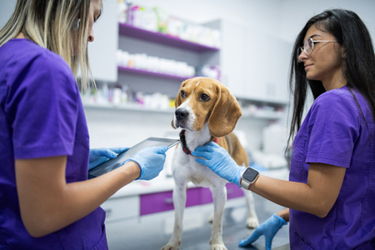Development Of A Novel Canine Prostatectomy Model
By Emily Griffith, Megan Haney, Ahmed Abdalla, and Porsha Osborne

Due to the many anatomical similarities between dogs and humans, canines are considered an ideal model for studying human prostate disorders, including prostate cancer. In humans, total prostatectomy is commonly performed to remove cancerous tissue, but this procedure is challenging to replicate in dogs due to a high rate of serious complications.
The aim of this study was to develop a canine prostatectomy model that would allow for future investigation of locally applied test materials while minimizing the post-operative complications typically seen in canine prostatectomy procedures. Three male Beagles underwent partial prostatectomy, where they were sedated with dexmedetomidine, acepromazine, and buprenorphine, induced with alfaxalone, and maintained on isoflurane. Preoperative care included carprofen, buprenorphine ER, and cefazolin. A pocket was created within the periprostatic fat through an abdominal incision, and approximately 25% of each prostatic lobe was removed via wedge resection, ensuring the urethra was avoided. The resection sites allowed for the direct application of test materials and the incision was closed in three layers using an absorbable suture. Carprofen was administered for two days post-operatively, and euthanasia was performed five days later for assessment of gross abnormalities.
All animals successfully underwent partial prostatectomy with no major surgical complications, such as urinary incontinence or retention. Pre-euthanasia free-catch urinalysis revealed hematuria and proteinuria, and at necropsy, gross findings included focal discoloration in renal tissue and at the resection site. Histologically, there was minimal to mild vacuolation and intracellular brown pigment in the renal tubular epithelium, which was not considered adverse. One dog showed a focal adhesion between the urinary bladder and the omentum. This partial prostatectomy model can be achieved with minimal complications and provides a promising refinement to the more invasive total prostatectomy, closely mimicking human prostatectomy procedures by allowing for prostate tissue manipulation and removal. Future studies will assess the improvement of post-operative hematuria and proteinuria and investigate the efficacy and safety of locally applied test materials, potentially opening the door to new therapeutics for prostate cancer and other prostate disorders.
Get unlimited access to:
Enter your credentials below to log in. Not yet a member of Drug Discovery Online? Subscribe today.
